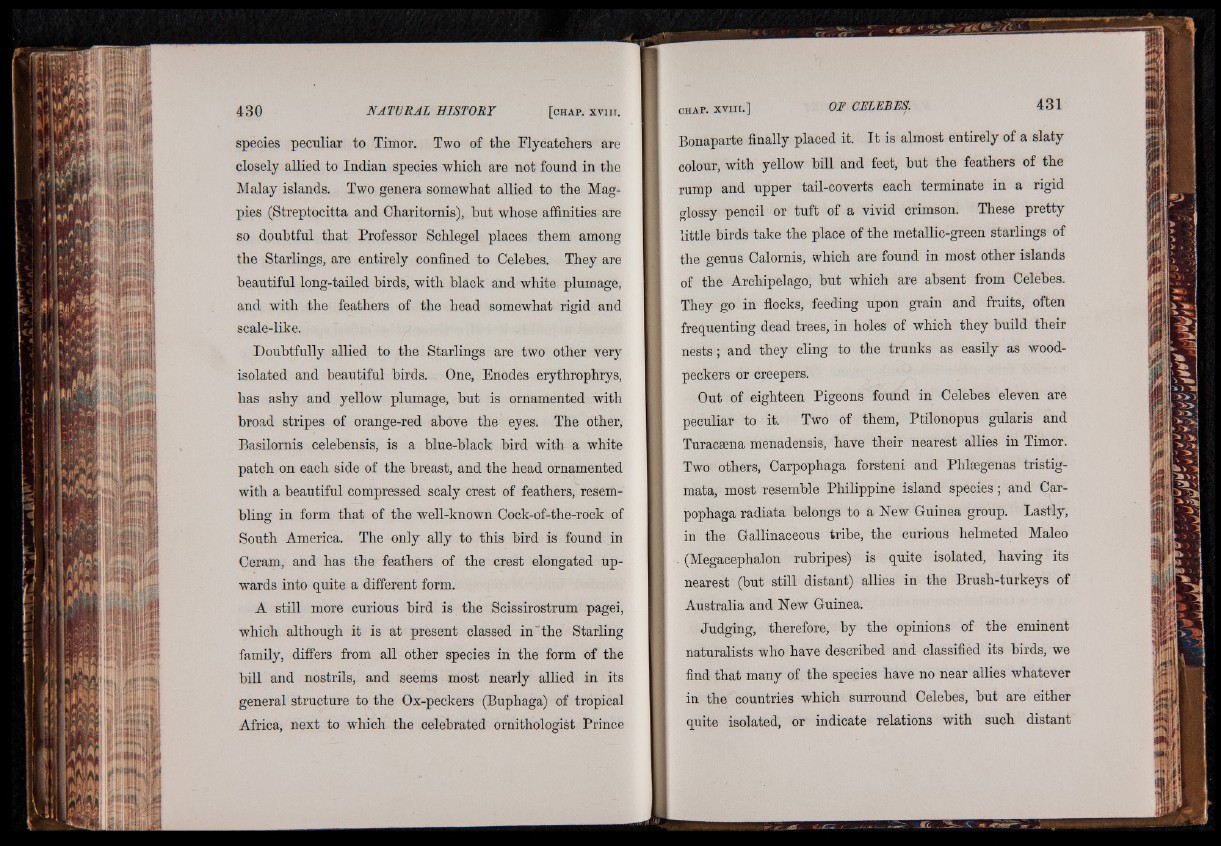
species peculiar to Timor. Two of the Flycatchers are
closely allied to Indian species which are not found in the
Malay islands. Two genera somewhat allied to the Magpies
(Streptocitta and Charitornis), hut whose affinities are
so doubtful that Professor Schlegel places them among
the Starlings, are entirely confined to Celebes. They are
beautiful long-tailed birds, with black and white plumage,
and with the feathers of the head somewhat rigid and
scale-like.
Doubtfully allied to the Starlings are two other very
isolated and beautiful birds. One, Enodes erythrophrys,
has ashy and yellow plumage, but is ornamented with
broad stripes of orange-red above the eyes. The other,
Basilornis celebensis, is a blue-black bird with a white
patch on each side of the breast, and the head ornamented
with a beautiful compressed scaly crest of feathers, resembling
in form that of the well-known Cock-of-the-rock of
South America. The only ally to this bird is found in
Ceram, and has the feathers of the crest elongated upwards
into quite a different form.
A still more curious bird is the Scissirostrum pagei,
which although it is at present classed in ‘the Starling
family, differs from all other species in the form of the
bill and nostrils, and seems most nearly allied in its
general structure to the Ox-peckers (Buphaga) of tropical
Africa, next to which the celebrated ornithologist Prince
Bonaparte finally placed it. It is almost entirely of a slaty
colour, with yellow bill and feet, but the feathers of the
rump and upper tail-coverts each terminate in a rigid
glossy pencil or tuft of a vivid crimson. These pretty
little birds take the place of the metallic-green starlings of
the genus Calornis, which are found in most other islands
of the Archipelago, but which are absent from Celebes.
They go in flocks, feeding upon grain and fruits, often
frequenting dead trees, in holes of which they build their
nests; and they cling to the trunks as easily as woodpeckers
or creepers.
Out of eighteen Pigeons found in Celebes eleven are
peculiar to it. Two of them, Ptilonopus gularis and
Turacama menadensis, have their nearest allies in Timor.
Two others, Carpophaga forsteni and Phlsegenas tristig-
mata, most resemble Philippine island species ; and Carpophaga
radiata belongs to a Hew Guinea group. Lastly,
in the Gallinaceous tribe, the curious helmeted Maleo
. (Megacephalon rubripes) is quite isolated, having its
nearest (but still distant) allies in the Brush-turkeys of
Australia and Hew Guinea.
Judging, therefore, by the opinions of the eminent
naturalists who have described and classified its birds, we
find that many of the species have no near allies whatever
in the countries which surround Celebes, but are either
quite isolated, or indicate relations with such distant